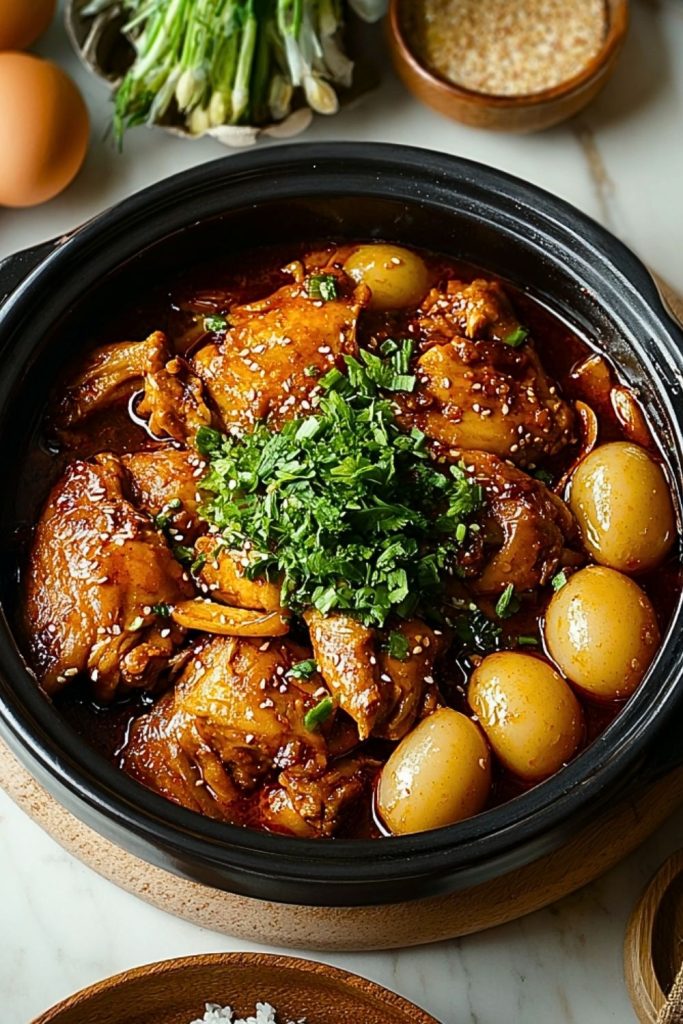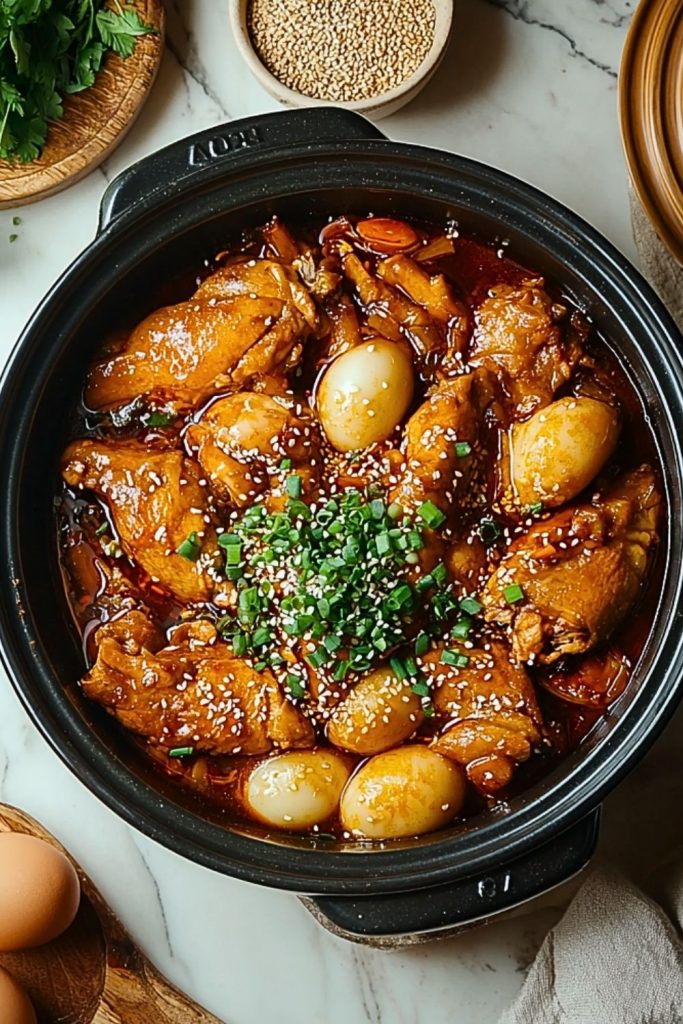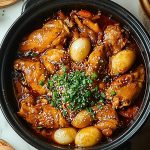When I first tasted Jjimdak, it completely changed the way I thought about comfort food. Rich, savory, slightly sweet, and deeply aromatic — this Korean braised chicken dish wraps you in warmth with every bite. The glossy, soy-based sauce seeps into tender chicken, soft potatoes, and chewy rice cakes (if you add them), making it the kind of dish that brings people together around the table. I still remember how the first spoonful made me pause — it had the perfect balance of heat, sweetness, and umami. That was all it took for Jjimdak to become a go-to dish in my kitchen.

This isn’t a quick toss-together recipe, but it’s not complicated either. Jjimdak is a slow braise that rewards your patience with depth and heartiness. Whether you’re craving a one-pot meal or looking to impress someone with a dish that feels both homey and special, Jjimdak delivers every time. Let’s break it down together — step by step.
Why You’ll Love This Jjimdak Recipe
This dish has all the rich, savory satisfaction of a stew but with unmistakably Korean flavors — think garlic, soy sauce, sesame oil, and a hit of gochugaru (Korean red pepper flakes). It’s incredibly versatile: you can load it up with vegetables, make it spicier or sweeter, or even keep it milder for the kids. Plus, it’s perfect for batch cooking and reheats like a dream.
What Kind of Chicken Should I Use for Jjimdak?
For the most flavorful and tender result, I recommend using bone-in, skin-on chicken pieces, especially thighs and drumsticks. The bones help infuse the broth with richness during braising, and the skin adds a beautiful depth of flavor. If you’re short on time or prefer leaner meat, boneless skinless chicken thighs are a solid alternative — they stay juicy and absorb the sauce well. While you can use chicken breast, it tends to dry out more quickly during the long simmer, so it’s not ideal for Jjimdak.
Options for Substitutions
While traditional Jjimdak has its set of core ingredients, there’s room to make it your own:
- Potatoes: Swap with sweet potatoes or Korean radish for a different texture and mild sweetness.
- Glass noodles: Optional but delicious — if unavailable, try Korean sweet potato noodles or skip entirely.
- Gochugaru (Korean chili flakes): Use a milder chili powder or paprika if you’re heat-sensitive, or increase for extra spice.
- Soy sauce: For a gluten-free version, tamari is a great alternative.
- Rice cakes: These chewy bites are optional, but if you’re looking for a fun twist, toss them in during the last 10 minutes of cooking.
Make sure to adjust seasoning if you substitute — Jjimdak is all about that rich balance between salty, sweet, and spicy.
Ingredients for This Jjimdak Recipe
Each ingredient in Jjimdak plays a key role in building its rich, layered flavor. Here’s what you’ll need and why:
- Chicken (bone-in thighs and drumsticks) – The star of the dish. These cuts become incredibly tender when braised and release deep flavor into the sauce.
- Potatoes – They soak up the sauce beautifully and add hearty comfort to the dish.
- Carrots – For natural sweetness and a soft texture that balances the savory notes.
- Onion – A base ingredient that mellows out and adds aromatic depth.
- Garlic – Essential for that bold, Korean-style umami.
- Ginger – Brightens up the dish and cuts through the richness.
- Soy Sauce – Brings deep, salty umami flavor and creates the rich brown sauce.
- Brown Sugar – Adds sweetness to balance the soy sauce and spice.
- Gochugaru (Korean red chili flakes) – Delivers a gentle heat and signature red hue.
- Sesame Oil – A finishing touch that adds nuttiness and depth.
- Mirin or Rice Wine – Helps tenderize the chicken and sweetens the broth subtly.
- Water or Chicken Broth – The braising liquid that ties it all together.
- Green Onion – For freshness and garnish.
- Sesame Seeds – Optional, but add texture and visual appeal when sprinkled on top.
- Korean Glass Noodles (optional) – Absorb the sauce and provide that iconic chewy texture.
- Korean Rice Cakes (optional) – Another optional but satisfying addition that soaks up the sauce beautifully.

Step 1: Prep Your Ingredients
Start by chopping your vegetables — peel and cube the potatoes, slice the carrots into thick rounds, and roughly chop the onion. Mince the garlic and ginger finely. If you’re using glass noodles or rice cakes, soak them in warm water now so they’ll be ready to add later.
Step 2: Sear the Chicken
In a large, deep pot or Dutch oven, heat a bit of oil over medium-high heat. Add the chicken pieces in a single layer and sear them until lightly golden on all sides. This step locks in flavor and gives your chicken a nice color.
Step 3: Build the Base
Once the chicken is seared, toss in the onions, garlic, and ginger. Stir everything together for 2–3 minutes until the aromatics are fragrant and slightly softened. This is when your kitchen will start to smell incredible.
Step 4: Add Sauce & Simmer
Pour in soy sauce, brown sugar, mirin (or rice wine), gochugaru, and water or chicken broth. Stir well to combine. Add in the potatoes and carrots. Bring the mixture to a boil, then reduce the heat and cover. Let it simmer gently for 25–30 minutes until the chicken is cooked through and the vegetables are soft.
Step 5: Add Optional Ingredients
If you’re using soaked glass noodles or rice cakes, add them to the pot in the last 10 minutes of cooking. Let them soak up the sauce and become tender. Stir occasionally so nothing sticks to the bottom.
Step 6: Final Touches
Drizzle in sesame oil and give everything a gentle mix. Taste and adjust seasoning — more soy sauce for salt, more sugar for sweetness, or more gochugaru if you like it spicier. Top with chopped green onions and sesame seeds before serving.
How Long to Cook the Jjimdak
The total cooking time for Jjimdak is around 40–45 minutes, depending on the cut and size of your chicken. Here’s a breakdown:
- Searing the chicken: 5–7 minutes
- Simmering with sauce and vegetables: 25–30 minutes
- Final simmer with noodles or rice cakes: 8–10 minutes
You’ll know it’s ready when the chicken is fully cooked and tender, the potatoes are soft, and the sauce has thickened slightly to coat everything beautifully.
Tips for Perfect Jjimdak
- Cut ingredients into similar sizes: This helps everything cook evenly, especially the potatoes and carrots.
- Adjust the heat to your liking: Start with less gochugaru if you’re not a fan of spice — you can always add more later.
- Don’t rush the simmer: The longer it simmers (on low heat), the deeper the flavor.
- Use a wide pot or Dutch oven: This gives everything room to braise evenly and allows better sauce reduction.
- Soak noodles and rice cakes early: They’ll cook much faster and absorb the flavor better once added in.
- Skim off extra fat: If using skin-on chicken, you may see some fat rise to the top — feel free to skim it for a cleaner sauce.
Watch Out for These Mistakes While Cooking
Even though Jjimdak is a forgiving recipe, a few missteps can affect the final flavor or texture. Here’s what to watch for:
- Overcrowding the pot: If the chicken pieces are crammed too tightly, they’ll steam instead of sear. Use a large enough pot or sear in batches.
- Undercooking the vegetables: Make sure the potatoes and carrots are fork-tender before serving. Hard chunks will ruin the comforting texture.
- Skipping the soak for noodles or rice cakes: If added dry, they won’t cook evenly and can soak up too much liquid, leaving the dish dry.
- Boiling too aggressively: Braising is about slow and steady heat. A rolling boil can toughen the meat.
- Not tasting the sauce: The balance of salty, sweet, and spicy is key. Taste before serving and tweak as needed.
- Using too much liquid: Jjimdak should be saucy, not soupy. Stick to the liquid amounts and let it reduce naturally.
- Adding sesame oil too early: It loses its aroma when cooked too long — always drizzle at the end for the best flavor.
What to Serve With Jjimdak?
Pairing Jjimdak with the right sides can turn it into a full Korean-inspired meal. Here are my go-to companions:
Steamed White Rice
Soft, neutral rice is the perfect vehicle to soak up the savory sauce.
Kimchi
The tangy, spicy crunch of fermented cabbage balances out the richness of the braised chicken.
Korean Pickled Radish (Danmuji)
Bright, sweet, and vinegary — this helps cleanse your palate between bites.
Japchae
These stir-fried glass noodles echo the textures of Jjimdak and bring another layer of flavor.
Sautéed Spinach (Sigeumchi Namul)
A simple banchan (side dish) that adds color and lightness to your plate.
Cucumber Salad
Cool and refreshing, it contrasts beautifully with the warm, bold flavors of the stew.
Korean Egg Rolls (Gyeran Mari)
Soft and savory rolled omelets that are mild and great for balance.
Seaweed Soup (Miyeok Guk)
A nourishing side that brings even more comfort and a light broth to round out the meal.
Storage Instructions
Jjimdak keeps incredibly well, making it perfect for leftovers or meal prep. Here’s how to store it properly:
- Refrigerator: Let the dish cool completely before transferring to an airtight container. Store in the fridge for up to 4 days. Reheat gently over the stove or in the microwave, adding a splash of water if the sauce has thickened too much.
- Freezer: You can freeze Jjimdak without the noodles or rice cakes (they don’t freeze well). Store in a freezer-safe container for up to 2 months. Thaw overnight in the fridge before reheating on the stove.
Tip: If you’re planning to make extra for freezing, cook the noodles separately and add them fresh when reheating for the best texture.
Estimated Nutrition
The following is an approximate breakdown per serving (based on a 5-serving batch with bone-in chicken and no rice):
- Calories: 460
- Protein: 34g
- Carbohydrates: 28g
- Fat: 22g
- Saturated Fat: 5g
- Cholesterol: 140mg
- Sodium: 980mg
- Sugar: 10g
- Fiber: 3g
Note: Nutritional values will vary depending on the exact ingredients and any substitutions used.
Frequently Asked Questions
What does “Jjimdak” mean?
“Jjimdak” (찜닭) translates to “braised chicken” in Korean. “Jjim” means to steam or braise, and “dak” means chicken. It’s a traditional dish from the city of Andong in South Korea.
Can I make Jjimdak less spicy?
Absolutely. Simply reduce or omit the gochugaru (Korean red chili flakes). You can also add a little more sugar to balance any residual heat.
Is Jjimdak gluten-free?
It can be! Just swap out the regular soy sauce for tamari or a certified gluten-free soy sauce. Also, make sure your noodles and rice cakes (if using) are gluten-free.
Can I use a slow cooker or Instant Pot?
Yes! For a slow cooker, cook on low for 6–7 hours. For an Instant Pot, pressure cook on high for 15 minutes, then do a quick release. Add noodles or rice cakes at the end and simmer on sauté mode.
What type of noodles are best for Jjimdak?
Sweet potato glass noodles (dangmyeon) are the most traditional. They’re chewy, neutral in flavor, and soak up the sauce wonderfully.
Do I need to peel the potatoes and carrots?
Peeling is recommended, especially for potatoes, to help them absorb the sauce and avoid an earthy taste. Carrots can be left with skin if scrubbed clean, but peeling gives a softer texture.
Can I prepare Jjimdak in advance?
Yes — in fact, it often tastes even better the next day as the flavors continue to develop. Store it in the fridge and reheat gently when ready to serve.
Can I double the recipe for a party or potluck?
Definitely! Just make sure you use a large enough pot to accommodate everything and increase simmering time slightly to ensure all chicken cooks through evenly.
Conclusion
Jjimdak is one of those dishes that feels like a warm hug in a bowl — savory, slightly sweet, comforting, and layered with flavor. Whether you’re cooking it for a cozy night in, a family dinner, or your first adventure into Korean cuisine, this dish has a way of making the whole house smell amazing and the people around your table happy. It’s not just food — it’s an experience worth sharing.

Jjimdak Korean Braised Chicken
- Prep Time: 15 minutes
- Cook Time: 30 minutes
- Total Time: 45 minutes
- Yield: 5 servings
- Category: Main Dish
- Method: Braising
- Cuisine: Korean
Description
Craving bold flavors and ultimate comfort in one dish? This Jjimdak (Korean Braised Chicken) is everything you need in a single pot — tender chicken braised in a sweet, savory, and mildly spicy soy-based sauce, with melt-in-your-mouth potatoes, chewy noodles, and aromatic garlic-ginger goodness. Perfect as a quick dinner idea, a cozy weekend meal, or an introduction to Korean food culture. This easy recipe is packed with flavor, family-friendly, and reheats beautifully. Whether you’re into Asian food ideas, want an easy dinner recipe, or need a new cozy fall meal, Jjimdak checks all the boxes.
Ingredients
900g bone-in chicken thighs and drumsticks
2 medium potatoes, peeled and cut into chunks
1 large carrot, sliced
1 large onion, chopped
5 cloves garlic, minced
1 tablespoon fresh ginger, minced
1⁄2 cup soy sauce
2 tablespoons brown sugar
1 tablespoon mirin or rice wine
1 tablespoon gochugaru (Korean red pepper flakes)
1 tablespoon sesame oil
2 cups water or chicken broth
2 green onions, chopped
1 tablespoon sesame seeds (optional)
120g Korean glass noodles, soaked (optional)
150g Korean rice cakes, soaked (optional)
Instructions
1. Prepare all your vegetables: peel and chop the potatoes, slice carrots, and chop the onion. Mince garlic and ginger. Soak noodles and rice cakes in warm water if using.
2. In a large pot or Dutch oven, heat a splash of oil over medium-high heat. Sear the chicken pieces until browned on all sides.
3. Add onion, garlic, and ginger to the pot. Stir and cook for 2–3 minutes until fragrant.
4. Pour in the soy sauce, brown sugar, mirin, gochugaru, and water or broth. Stir to combine.
5. Add potatoes and carrots to the pot. Bring to a boil, then reduce heat to low. Cover and simmer for 25–30 minutes.
6. Add soaked noodles or rice cakes during the last 10 minutes of cooking. Stir occasionally to prevent sticking.
7. Drizzle in sesame oil, then taste and adjust seasoning if needed.
8. Serve hot, topped with chopped green onions and sesame seeds.
Notes
This dish gets better the next day — leftovers are a must.
For a less spicy version, reduce or skip the gochugaru.
Only add sesame oil at the end to preserve its nutty aroma.
Nutrition
- Serving Size: 1 portion
- Calories: 460
- Sugar: 10g
- Sodium: 980mg
- Fat: 22g
- Saturated Fat: 5g
- Unsaturated Fat: 14g
- Trans Fat: 0g
- Carbohydrates: 28g
- Fiber: 3g
- Protein: 34g
- Cholesterol: 140mg
Keywords: jjimdak, Korean braised chicken, easy dinner, comfort food, spicy chicken recipe, Asian chicken, chicken stew

